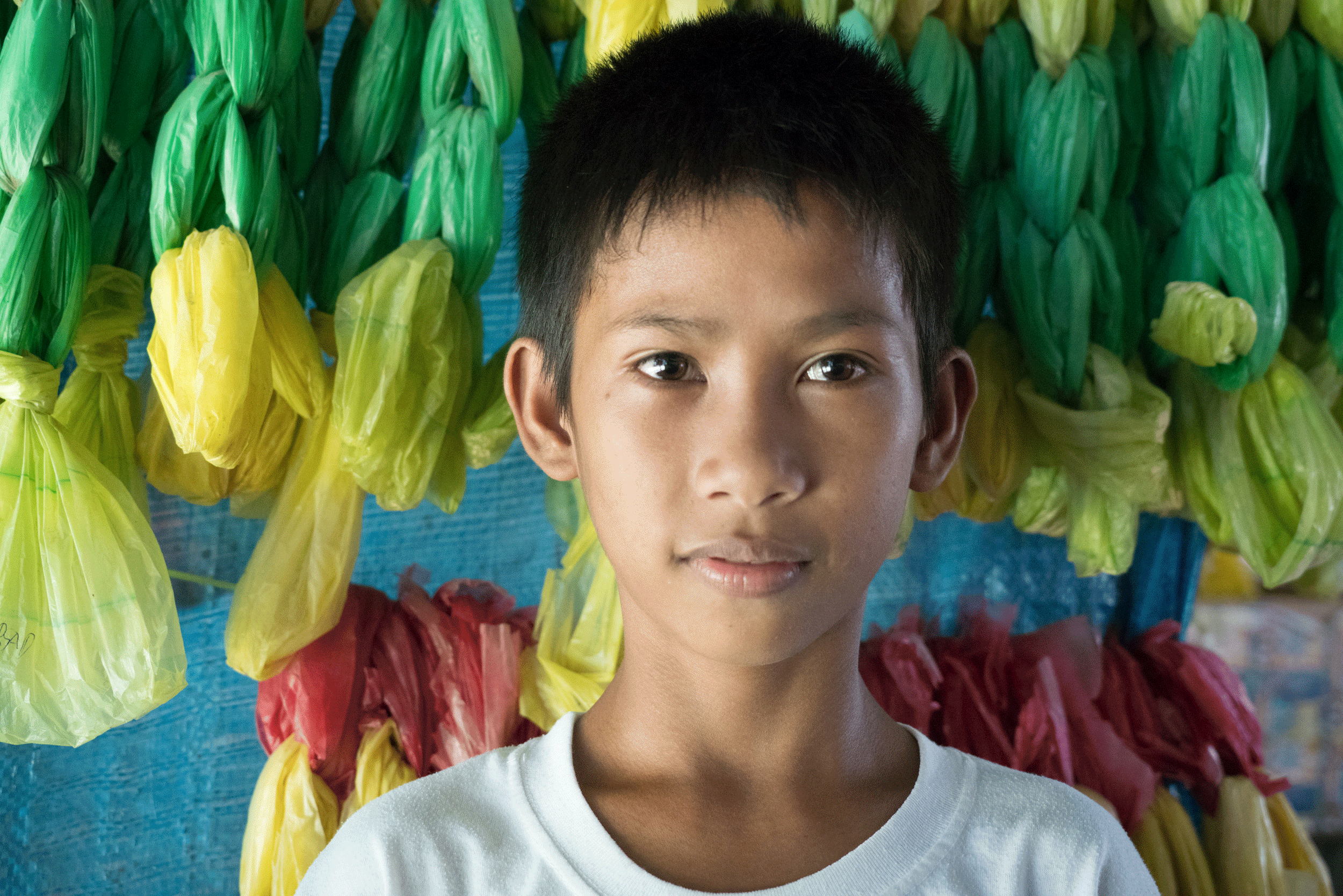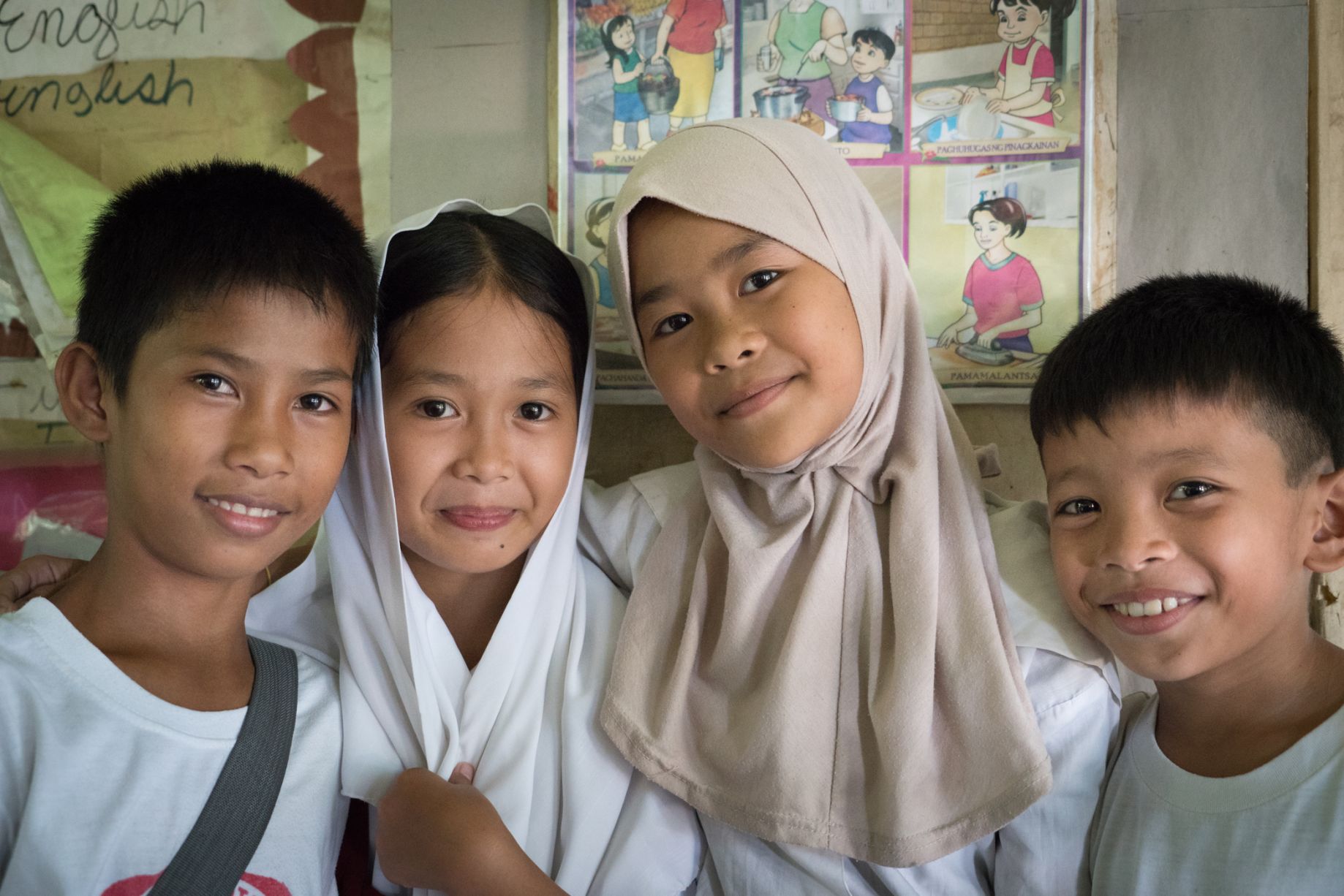“A, B, C, D… Boom! A big explosion. We were all panicking. Little did we know that a bazooka had just landed inside our school,” Bayang Pangilinan, Principal of Katibpuan Elementary School recalls an experience she had some years ago.
As soon as the loud blast and gun shots stopped, teachers and students all hurried out of the classroom.

Bayang Pangilinan, principal of Katibpuan Elementary School in Maguindanao.
“I even left my shoes because of the panic. Parents are running towards the school. They were all scared and many were crying. I will never forget that day,” she shares as she sits in front of an IOM-refurbished classroom in Maguindanao, a province in the Southern region of Mindanao, in the Philippines.
Most of the students here, if not all, have experienced the trauma of conflict and have been evacuees themselves which has left them particularly vulnerable. Even in cases where they found safety, getting quality education remains a great challenge. Also, the horrific memories and trauma of the various conflicts will likely stay with them for a long time.
IOM’s Children of Peace project aims to fight this and contribute to the urgent need for child protection and resilience in conflilct-affected areas in Mindanao by increasing access to, and sustain safe and quality education.
Maguindanao through the years
Various armed conflicts and natural disasters such as cyclones and flooding have led to displacement of people in Mindanao, located at the Southern tip of the Philippines. As of early 2016, more than 167,000 people are internally displaced and remain in need of immediate assistance.
Protracted displacements have caused severe and traumatic effects, particularly on children, who comprise more than half of all the recorded internally displaced persons (IDPs).

Classrooms are left untouched after the attacks.
Due to recurring conflicts and protracted displacements, these children do not have access to safe and quality learning spaces and facilities. Many need life-saving assistance including nutritional and psychosocial support.
Initial assessment also revealed that local capacities need to be enhanced to enable safe and quality education for conflict-affected children.
Despite all of these unfortunate factors, the students, who proudly call themselves Children of Peace, are not disheartened and continue to go to school, leaving their fears and traumas behind.
Here are some of the brave children who despite everything, are making sure nothing stops them from learning.

Ameerah, 10
Ameerah
“It is scary to know that fighting can happen any moment. I’m particularly afraid that something bad will happen to my family,” Ameerah, 10, says as she sits down inside her classroom.
Ameerah was once an evacuee herself. She has seen many people who got hurt and wounded during conflict. That is the reason why she aspires to be a doctor in the future and help those who need medical assistance in case of emergencies.
Ameerah also enjoys watching television series on weekends. “I watch a lot of television shows to practice my English and Filipino skills. This way, I enjoy and learn at the same time.”

Ameerah inside an IOM refurbished classroom in Katibpuan Elementary School.
She also enjoys planting and harvesting at IOM’s demo gardening project at the back of their school. “It is really fun to help in the demo garden and then see your harvest being used for our daily lunches.”
When asked about what she thinks can stop the fighting in their province, Ameerah says, “They must get together and have a peaceful dialogue. That’s what the fighting groups should do so conflict will end in this place.”

Anajia, 8, former evacuee from Maguindanao.
Anaija
“My family had to hop onto a truck full of people. I was young then and I don’t know exactly what was happening. All I know is that on that day, I became an evacuee,” Anaija, 8, says as she finishes erasing what’s written on her classroom chalkboard.
Having experienced being displaced, she says it is more challenging to concentrate on school when worries of conflict breaking out occupy her mind every now and then.
“This is the reason why when I grow up, I would like to be a teacher. First thing I will teach kids is peace,” Anaija shyly shares while fixing her hijab inside the IOM refurbished classroom.

Ameerah and Anajia grow crops in IOM's Demo Farm.
“I hope my family won’t need to evacuate again. It is hard to leave everything behind without knowing if you will ever go back again. It’s also hard to leave friends behind. Weekend are always extra fun with them,” she adds.

Fahad, 10, former evacuee from Maguindanao.
Fahad
“I walk muddy roads everyday for half an hour with my little brother to go to school. We make sure that no matter what, we will not miss our classes,” Fahad, 10, reveals as he gets ready to head back home from school.
“I’ve experienced being an evacuee. I don’t know who was fighting who, but I will not forget the gun shots,” he says with a serious expression on his face.
Despite this traumatic experience, Fahad still enjoys things that kids his age do. “When there is no school work, my friends and I play basketball. Through the game, I learn discipline, teamwork and sportsmanship.”

Fahad recites during class in Katibpuan Elementary School.
When asked about his future, Fahad enthusiastically answers: “Police! That’s what I want to be when I grow up. I will try my best to stop the fighting. But before that, I need to finish school first.”

Haimar, 12, former evacuee from Maguindanao.
Haimar
“I had to stop schooling. I was so sad because I don’t want to stop going to my classes. I thought I will never finish school anymore,” Haimar, 12, recalls when his family had to leave when conflict broke out near their neighborhood.
“Thankfully, I was able to go back to school. I wish for that experience to not happen again. I’m scared that in the next one, my family won’t be as lucky.”

Haimar enjoying his free time in school.
When asked about what he thinks will stop the fighting, Haimar says that peaceful talks are the key.
“If only they set aside the anger and put down their guns, then they can talk peacefully and innocent people won’t have to leave their homes, especially kids who are forced to stop schooling,” he says.
Ameerah and Anajia along with other students grow crops in IOM initiated Demo Farm in Katibpuan Elementary Schools.
IOM's WASH Programme inside Katibpuan Elementary School.
Classroom activities at Katibpuan Elementary School.
Fahad practicing proper hand washing after the feeding programme.
Fahad practicing proper hand washing after the feeding programme.
IOM intervention
“Lunch time,” one kid shouts as another school day ends. But unlike at other schools, students here don’t go rushing home. Instead, they take their plates, cups and utensils and head out to a long table outside the classroom.
To support the needs of conflict-affected children, IOM provided lifesaving services, including food aid. IOM has also provided the school kitchen tools and eating utensils which they use everyday during lunch.

To teach children how to grow and harvest their own food, a demo gardening project was also initiated by IOM. This teaches students basic farming techniques and provides pupils hands-on gardening training. The crops and goods from the demo garden is also being used on the feeding programme.
In addition, IOM has also provided water, sanitation and hygiene (WASH), health, nutrition and psycho-social services. A handwashing station was installed which students use before lunch.
With schools, sometimes being a casualty of bombings and gun shots, IOM has also focused on repairing and refurbishing of temporary or permanent learning spaces accompanied by provision of school supplies.

Capacity-building activities for teachers and other educational personnel were given, focusing in emergencies, disaster risk reduction and other essential capacities to facilitate safe and quality education for children in the area.
The Children of Peace project is funded by the European Commission’s Humanitarian Aid and Civil Protection (ECHO) and is implemented in partnership with the local non-governmental organization, Assistance and Cooperation for Community Resilience and Development (ACCORD).

From left: Haimar, Ameerah, Anaija and Fahad, proud members of the Children of Peace Project.
Protracted crises like this not only temporarily interrupt children’s education and lives, but can also close the door on education for a lifetime if necessary support is not given.
“I don’t want to imagine what a real classroom is because bombs will always destroy it. I want to be in it to see it. Peace is what we need and not violence. I hope one day, conflict will just end,” one of the kids shares as she tucks away her eating utensils and heads home.
